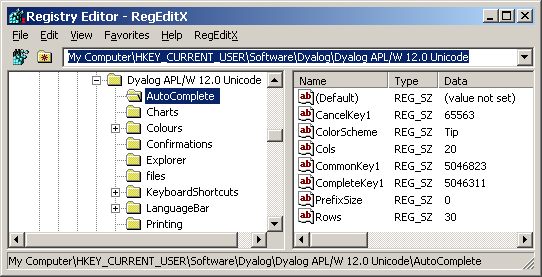|
Size: 2726
Comment:
|
Size: 2960
Comment:
|
| Deletions are marked like this. | Additions are marked like this. |
| Line 1: | Line 1: |
| ## page was copied from WinReg | |
| Line 7: | Line 8: |
| This class offers methods useful to deal with the Windows Registry without using .NET. | This class offers methods useful to deal with the Windows Registry without using .NET. It uses `⎕NA` calls to the appropriate Windows API. `WinReg` is a powerful class that offers plenty of methods. If you just want to read, write and/or delete values from the Windows Registry then the much smaller class [[WinRegSimple]] might be sufficient. |
| Line 10: | Line 13: |
| To understand the names of the methods you need to understand the terminology. If you find the terminology strange: so do I, but it was invented by Microsoft and got widely accepted. That is the reason why I decided to go for it: it makes it easier to understand others while talking about the Windows Registry. | To understand the names of the methods you need to understand the terminology. If you find the terminology strange: so do I, but it was invented by Microsoft and therefore defines the standard. That is the reason why I decided to go for it: it makes it easier to understand the Microsoft documentation but also to understand others while talking about the Windows Registry. |
| Line 16: | Line 19: |
| you can see that this string is visible in the top of the window: | you can see this string: |
| Line 20: | Line 23: |
| at the top of the window. |
|
| Line 21: | Line 26: |
| This is called a "Main key". There is a particular number of pre-defined main keys available you can choose from. For the most important one from an application programmers view there is also a shortcut available: Instead of '''HKEY_CURRENT_USER''' you can use '''HKCU'''. | This is called a "Main key". There are a number of pre-defined main keys available you can choose from. There is also a shortcut available: instead of '''HKEY_CURRENT_USER''' you can use '''HKCU'''. |
| Line 24: | Line 29: |
| This is called a '''subkey'''. | This is called a '''sub key'''. |
| Line 26: | Line 31: |
| On the right side you see a list. The entries in this list are called "value". '''!CancelKey1''' is there a value. The actual data saved under this value is called "data". | On the right side you see a list. The entries in this list are called "values". Therefore '''!CancelKey1''' is a value. Note that the '''''names''''' are called values; the actual data saved under a value is called "data". |
| Line 30: | Line 38: |
| Close CopyTree DeleteSubKey DeleteSubKeyTree DeleteValue DoesKeyExist DoesValueExist |
|
| Line 39: | Line 54: |
| GetAllValueNames GetAllValues |
GetAllValueNames GetAllValues GetDyalogRegPath |
| Line 42: | Line 58: |
| GetString | GetString |
| Line 45: | Line 61: |
| GetTypeAsStringFrom GetValue History KeyInfo OpenAndCreateKey OpenKey PutBinary PutString PutValue Version |
GetTypeAsStringFrom GetValue History KeyInfo ListError ListReg OpenAndCreateKey OpenKey PutBinary PutString PutValue ReadByte |
| Line 77: | Line 94: |
== Download == [[http://aplwiki.com/WinReg?action=AttachFile&do=get&target=WinReg.ZIP|Download WinReg script right now]] |
<<Include(APLTreeDownloads)>> |
Dealing with the Windows Registry
WinReg is part of the CategoryAplTree project.
Contents
Overview
This class offers methods useful to deal with the Windows Registry without using .NET. It uses ⎕NA calls to the appropriate Windows API.
WinReg is a powerful class that offers plenty of methods. If you just want to read, write and/or delete values from the Windows Registry then the much smaller class WinRegSimple might be sufficient.
Terminology
To understand the names of the methods you need to understand the terminology. If you find the terminology strange: so do I, but it was invented by Microsoft and therefore defines the standard. That is the reason why I decided to go for it: it makes it easier to understand the Microsoft documentation but also to understand others while talking about the Windows Registry.
In this picture:
you can see this string:
HKEY_CURRENT_USER\Software\Dyalog\Dyalog APL/W 12.0 Unicode\AutoComplete
at the top of the window.
HKEY_CURRENT_USER
This is called a "Main key". There are a number of pre-defined main keys available you can choose from. There is also a shortcut available: instead of HKEY_CURRENT_USER you can use HKCU.
SOFTWARE\Dyalog\Dyalog APL/W 12.0 Unicode
This is called a sub key.
On the right side you see a list. The entries in this list are called "values". Therefore CancelKey1 is a value.
Note that the names are called values; the actual data saved under a value is called "data".
Shared Methods
Close CopyTree DeleteSubKey DeleteSubKeyTree DeleteValue DoesKeyExist DoesValueExist Close CopyTree Copyright DeleteSubKey DeleteSubKeyTree DeleteValue DoesKeyExist DoesValueExist GetAllSubKeyNames GetAllValueNames GetAllValues GetDyalogRegPath GetErrorAsStringFrom GetString GetTree GetTreeWithValues GetTypeAsStringFrom GetValue History KeyInfo ListError ListReg OpenAndCreateKey OpenKey PutBinary PutString PutValue ReadByte
Restrictions
Note the following restrictions:
PutValue supports DWORDs (REG_DWORD)
PutBinary supports REG_BINARY
PutString and GetString support strings (REG_SZ), nested strings (REG_MULTI_SZ) and expanded strings (REG_EXPAND_SZ)
GetValue supports all data types.
Other data types can be requested via GetValue; however, writing them is not supported.
Project Page
For bug reports, future enhancements and a full version history see WinReg/ProjectPage
Version Information
Original author: |
|
Responsible: |
|
Email: |
 APL Wiki
APL Wiki